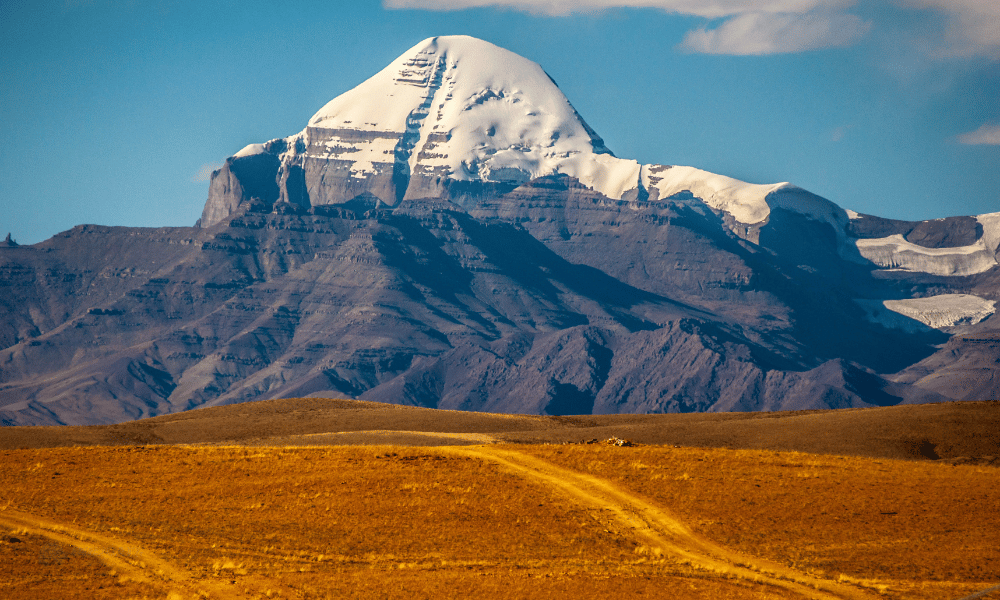As long as you wish to travel, preparations become inevitable, and cost is a significant part of it. The blog “How Much Does Kailash Mansarovar Yatra Cost” aims to be a comprehensive guide on the cost associated with undertaking the Kailash Mansarovar Yatra. It recognises the importance of financial planning for this once in a lifetime pilgrimage and strives to provide a clear breakdown of expenses. It will explore the three main routes for the Yatra; by Drive via the Kyirong Border, by Helicopter via Nepalgunj, and by Drive via Lhasa. For each route, a typical itinerary will be outlined, highlighting the key locations included.
The journey cost typically begins with travel expenses, including airfare or other transportation costs to reach Kathmandu, Nepal, the usual starting point. From there, obtaining the necessary permits and visas for travelling to the region is a significant financial aspect, with fees for the Chinese visa and Tibet Travel Permit adding to the initial investment. Many pilgrims opt for tour packages, which vary widely in cost depending on factors such as accommodation standards, meal provisions, and additional services. Understanding these cost components and planning accordingly will help you understand the structure of the trip and how it might influence the cost. Furthermore, it ensures that pilgrims can focus on the spiritual significance of the journey without any financial stress.
What is Kailash Mansarovar Yatra?
The Kailash Mansarovar Yatra is a spiritual journey undertaken by Hindus, Buddhists, Jains, and Bon followers to venerate Mount Kailash and Lake Manasarovar in the Himalayas. Believed to be a path to liberation, the pilgrimage involves traversing high altitudes for roughly 10 days. Mount Kailash, the abode of Lord Shiva, and the sacred Lake Manasarovar are both revered by these religions. The significance of the yatra extends beyond religious boundaries, with their natural beauty and spiritual aura drawing travellers.

The pilgrimage typically begins in Kathmandu, Nepal, where pilgrims gather before setting out for the journey. From Kathmandu, participants travel overland to the Kyirong border or by air to the town of Hilsa, and then continue the journey by vehicle and then on foot through rugged terrain to reach Lake Manasarovar and the parikrama of Mount Kailash. The journey is physically demanding due to the high altitude and challenging terrain, but it is also deeply rewarding for those seeking spiritual purification and enlightenment. Pilgrims often undertake rituals such as performing the parikrama (circumambulation) of Mount Kailash and taking a holy dip in the pristine waters of Lake Mansarovar, believed to cleanse one of sins and bring spiritual liberation. The entire Kailash Mansarovar Yatra is a test of one's physical endurance, determination, and faith and is regarded as a once in a lifetime pilgrimage for devout believers seeking divine and spiritual transformation.
Learn More: What is Kailash Mansarovar Yatra
How Much Does Kailash Yatra Cost?
The call of the Himalayas has always been alluring, and for many people, a pilgrimage to Mount Kailash and Lake Mansarovar is a dream. But before you decide to participate, it is important to consider the associated costs. Here’s the breakdown of the cost according to the various routes taken:
|
Route |
Cost |
|
By Drive via Kyirong border (Group Joining) |
USD 3000 per person |
|
By Drive via Kyirong border (Private) |
USD 5000 per person (2-3 pax) USD 4500 per person (4-6 pax) |
|
By Helicopter via Nepalgunj (Group Joining) |
USD 4200 per person |
|
By Drive via Lhasa (Group Joining) |
USD 6000 per person |
Learn More: How Much does Kailash Yatra Cost?
Cost Affecting Factors
With regards to the budget required for this sacred Kailash Mansarovar Yatra, there are various factors that can affect the cost. The time of travel plays a significant role, with peak seasons often commanding higher prices for transportation, accommodation, and other services. Careful consideration of the mode of transportation can also impact costs, as flying versus taking overland routes can vary in expense. Accommodation choices, ranging from basic guesthouses to luxury hotels in Nepal, present another opportunity for cost management.
By understanding these factors and implementing cost-saving options such as booking early, travelling during the offseason, and opting for budget-friendly options, pilgrims can navigate the financial aspects of the Kailash Mansarovar Yatra by ensuring a spiritually fulfilling journey that remains within their budgetary means. Given are some details for it:
Itinerary/Route
If you’re travelling via Nepal, there are multiple ways to reach Kailash Mansarovar, which depends on your preference and the comfort you want. You can choose the route by air via Nepalgunj and by drive via Kyriong border or Lhasa. The route you choose and the itinerary itself also affect the cost of your Yatra, where driving is comparatively cheaper than flying.
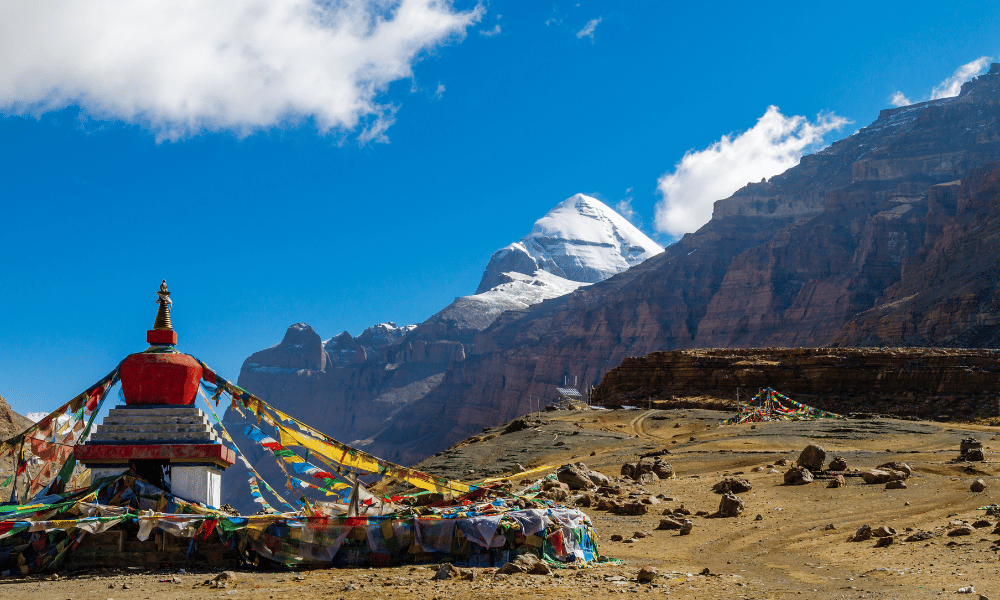
By Drive via Kyirong border
Travelling by car via the Kyirong border is often the most economical option. This route involves overland travel through Nepal, crossing the Kyirong border into Tibet. The costs are generally lower due to reduced airfare and the possibility of sharing transportation expenses with other pilgrims. However, the long drives and high altitude border crossings can require additional acclimatisation days, potentially increasing your stay and related expenses.
Outline Itinerary
|
DAY 01: Kathmandu Arrival. |
|
DAY 02: Kathmandu Sightseeing, Visa Application. |
|
DAY 03: Bhaktapur Sightseeing. |
|
DAY 04: Chandragiri Sightseeing. |
|
DAY 05: Packing and Final Preparation. |
|
DAY 06: Drive from Kathmandu to Dhunche or Syabrubesi or Timure. |
|
DAY 07: Drive to Kyirong. (2850 m) |
|
DAY 08: Drive to Saga. (4500m) |
|
DAY 09: Drive from Saga to Lake Mansarovar. (4650m) |
|
DAY 10: Drive to Darchen. (4700 m) |
|
DAY 11: Drive to Yama Dwara Trek to Deruphuk. (4050 m) |
|
DAY 12: Trek to Zuthulphuk. (4800m) |
|
DAY 13: Zuthulphuk to Saga. (4500m) |
|
DAY 14: Drive back to Kyirong. (2850M) |
|
DAY 15: Drive to Kathmandu. (1400m) |
|
DAY 16: Transfer to Airport. |
Learn More: Kailash Mansarovar Yatra by drive via Kyirong border
By Helicopter via Nepalgunj
Choosing this route significantly increases the cost but offers the advantages of convenience and time-saving. This route involves flying from Kathmandu to Nepalgunj and then taking a helicopter to Simikot, followed by a trek to the Tibet border. The higher expenses are due to the cost of helicopter services and additional flights, which provide a faster and less physically demanding alternative to the overland journey. This option is ideal for those who prefer a quicker route with less physical strain, despite the higher price tag.
Outline Itinerary
|
DAY 01: Kathmandu Arrival. (1400m) |
|
DAY 02: Kathmandu Sightseeing. |
|
DAY 03: Bhaktapur Sightseeing. |
|
DAY 04: Chandragiri Sightseeing. |
|
DAY 05: Pack and Fly to Nepalgunj. |
|
DAY 06: Fly from Nepalgunj to Simikot. (2910m) |
|
DAY 07: Simikot - Hilsa - Taklakot. (4025 m) |
|
DAY 08: At Taklakot – Rest Day Full Day – Free for Acclimatization. |
|
DAY 09: Drive from Taklakot to Lake Mansarovar. (4650m) |
|
DAY 10: Drive to Yama Dwara Trek to Deruphuk. (4050m) |
|
DAY 11: Trek to Zuthulphuk. (4800m) |
|
DAY 12: Zutulphuk to Hilsa or Simikot. |
|
DAY 13: Hilsa to Simikot, Fly back to Kathmandu via Nepalgunj. |
|
DAY 14: Transfer to Airport. |
Learn More: Kailash Mansarovar Yatra by Helicopter
By Drive via Lhasa
Travelling by drive via Lhasa is another popular route that tends to be on the more expensive side. This itinerary includes flying to Lhasa, the capital of Tibet, and then driving to Kailash Mansarovar. The costs are higher due to the flights to and from Lhasa, the need for multiple permits, and more luxurious accommodations available in Lhasa. This route offers a unique cultural experience, as pilgrims can spend time exploring the historical and spiritual landmarks of Lhasa before proceeding to Kailash.
Outline Itinerary
|
DAY 01: Kathmandu Arrival, Transfer to Hotel |
|
DAY 02: Flight to Lhasa (3656m). |
|
DAY 03: Lhasa City Tour. |
|
DAY 04: Drive to Shigatse (3860m). |
|
DAY 05: Drive to Everest Base Camp. |
|
DAY 06: Drive to Saga (4500m). |
|
DAY 07: Drive to Darchen via Lake Mansarovar (4650m). |
|
DAY 08: Trek to Deruphuk (4050m). |
|
DAY 09: Trek to Zuthulphuk (4800m). |
|
DAY 10: Trek to Darchen (4700m). |
|
DAY 11: Drive to Mansarovar (4650m). |
|
DAY 12: Drive to Saga (4500). |
|
DAY 13: Drive to Shigatse. |
|
DAY 14: Drive to Lhasa. |
|
DAY 15: Fly back to Kathmandu. |
|
DAY 16: Transfer to Airport. |
Learn More: Kailash Mansarovar Yatra by drive via Lhasa
Travel Style
While the life changing experience of the Yatra is priceless, the cost of the journey itself can vary depending on several factors, of which your preferred travel style is one. Breaking down the cost differentiation between private and group tours.
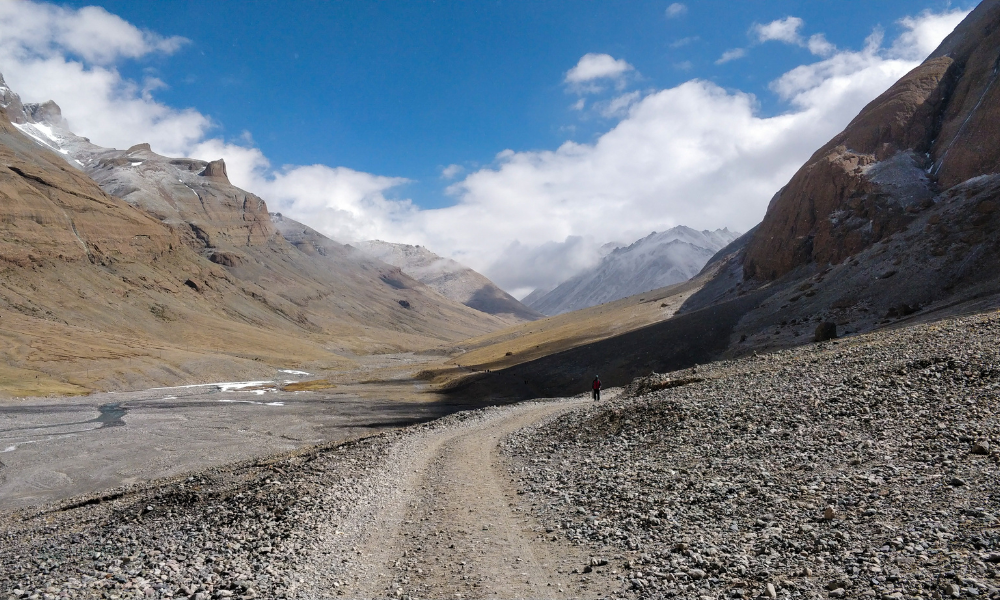
Private
A private tour generally ranges from 2-3 people to 4-6 people, which offers a more personalised experience with tailored services that include a dedicated guide, a customised itinerary, and more comfortable accommodations and transportation. While private tours offer the advantage of flexibility and personalised services, they tend to be more expensive compared to group tours due to the exclusivity and customisable nature of the arrangements. Pilgrims should budget accordingly for the higher costs associated with private tours, including accommodations, transportation, and support services. It is a suitable option for those who seek a more exclusive and flexible pilgrimage experience and are willing to invest more for these benefits.
Related Package: Kailash Mansarovar Private Tour
Group
Group tours are usually joint groups where the number of people in one group is 15 or above. It offers more affordable pilgrimage packages as they allow for cost-sharing across various expenses such as transportation, accommodation, and guide services. This makes group tours a cost-effective option for pilgrims seeking to minimise expenses while still participating in the sacred journey. While group tours may offer less flexibility in terms of itinerary and might involve basic accommodations, they provide a structured and supportive environment, which can be particularly beneficial for first time pilgrims.
Accommodations
The selection of accommodation on both the Nepal and Tibet sides plays a crucial role in determining the cost of the Kailash Mansarovar Yatra. Pilgrims must weigh their desire for comfort against their budget constraints, understanding that higher comfort and convenience come with increased expenses.
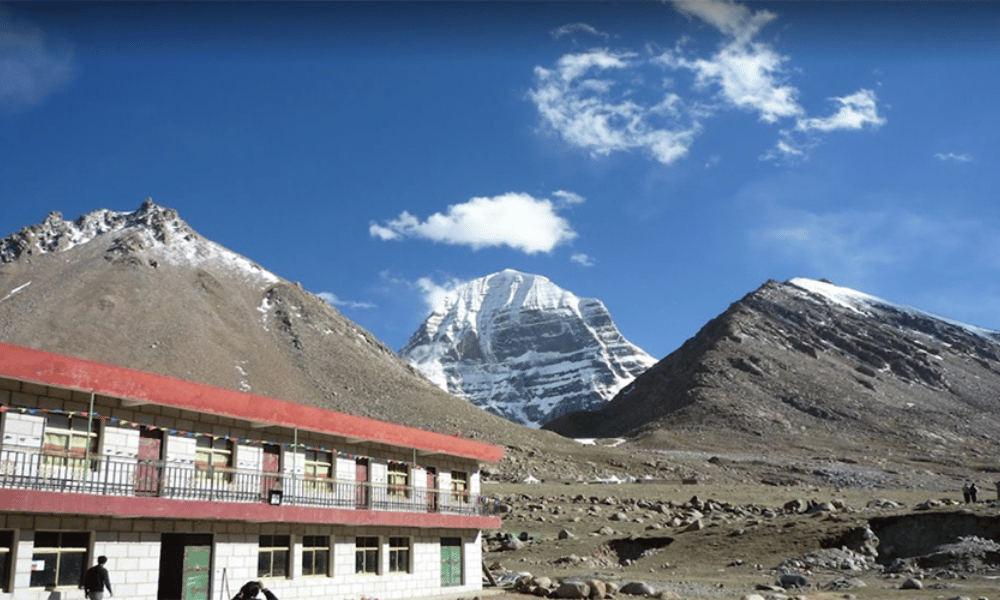
Nepal Side
On the Nepal side, as you’ll stay in Kathmandu, you'll find a range of hotels, from budget-friendly options to star rated hotels; 3 star, 4 star and 5 star. The amenities and comfort level generally surpass what's available on the Tibetan side. However, as you venture towards the border, accommodations become more basic, typically guest houses with shared facilities. The prices of your tour differ depending on your choice of stay in the various accommodation types. The more luxurious/star rated hotel you choose, the more the overall Yatra cost increases.
Tibet Side
As the yatra is in a remote region, the accommodations aren’t luxurious or fancy; you will be provided with the most accommodations, such as a local guest house/tea house. However, a comfortable and reliable stay is assured with basic amenities like electricity. If you’re travelling via Lhasa, you might find hotels that match your preferences there. However, as you go higher in altitude, the choices are limited, especially in places like Deruphuk and Zuthulphuk, where only one accommodation option might be available with minimum facilities. The more remote the region is, the more expensive the accommodation facility will be.
Transportation Mode
Any transportation mode you choose, reliable access to the destination ensures your comfort and safety for the whole journey. Kailash Mansarovar Yatra offers various transportation modes for both Nepal and Tibet, which affect the cost and are also dependent upon the number of people you’re travelling with and the travel style you choose.
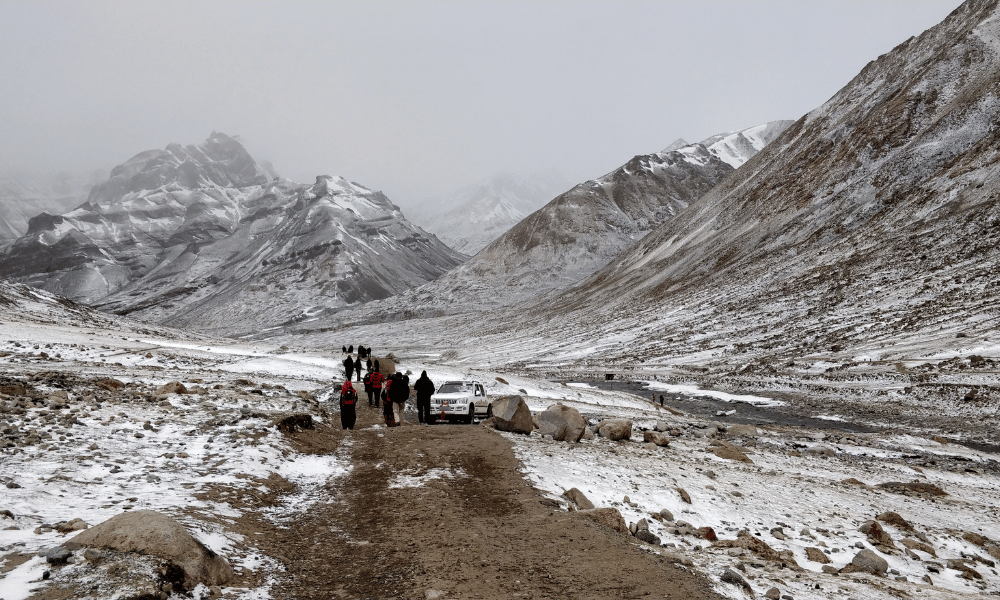
Nepal Side
Transportation options within Nepal include both road and air travel. Pilgrims can opt for buses or jeeps for overland journeys to the starting point of the yatra, according to their travel style. For those who prefer speed and convenience, flights from Kathmandu to Nepalgunj, then Simikot, followed by helicopter rides to Hilsa, are available, but at a significantly higher cost. These air travel options greatly reduce travel time and physical strain, making them a preferred choice for those with a higher budget.
Tibet Side
Group tours typically use shared transports, which include coaches/buses while private vehicles provide personalised experiences, which include jeeps/cars. In Tibet, transportation is primarily by road due to the rugged terrain and limited infrastructure. Pilgrims typically travel in jeeps or buses arranged by tour operators. Flights to and from Lhasa may also be available, although they tend to be more expensive than overland travel.
Meals
The Kailash Mansarovar Yatra offers pilgrims opportunities to experience the local culture and cuisine of both Nepal and Tibet. Nourishing your body is essential for a successful Kailash Mansarovar Yatra. However, the type of meal plan you consume influences your entire yatra cost. Find out more about it below:

Nepal Side
The cost of meals in Nepal can vary depending on the dining preferences of the pilgrims. Options range from local eateries serving traditional Nepali cuisine to international restaurants catering to diverse tastes. Pilgrims may also opt for meal packages provided by tour operators, which include breakfast, lunch, and dinner at designated restaurants or lodges.
Tibet Side
The meals included here are basic but sufficient. Each day, the food is based on Tibetan and Indian meals. You will have a packed lunch prepared by the cook staff accompanying you throughout your tour. Choosing specific foods or dietary needs can increase the cost. Given the pilgrimage journey, the meals are vegetarian, which will be fresh and healthy for your whole trekking period.
Number of Support Team
The size and composition of the support team accompanying the yatris play a crucial role in ensuring a safe and comfortable pilgrimage experience. Generally, one English speaking guide from Nepal, one English speaking guide from Tibet, and a cook staff are included in your support team, intended for smaller groups of about 2-3 people. If you wish to increase the support staff, you can do so based on your group's needs, which will increase the Yatra cost as well.
Nationality
There might not be much difference in the cost due to nationality, but Indian nationals do enjoy some privileges that can lessen the Yatra cost. Let’s find out how:
Non Indians
Foreign nationals undertaking the Kailash Mansarovar Yatra are required to obtain special permits and visas, which may involve additional costs. Permit fees for non-Indian citizens tend to be higher compared to those for Indian nationals. Additionally, foreign pilgrims may incur other expenses such as travel insurance, visa processing fees, and currency exchange charges.
Indians
Indian citizens enjoy certain privileges, such as lower permit fees and simpler visa procedures, which can help reduce the overall cost of the pilgrimage. However, they still need to budget for expenses such as transportation, accommodations, meals, and support services.
By carefully considering all these factors, you can find a Kailash Mansarovar Yatra Package that fits your budget and desired level of comfort.
Also Read: Kailash Mansarovar Yatra From UK Via Nepal
Travel Tips
While considering different factors of the cost associated with the Kailash Mansarovar Yatra, you might as well want some additional tips for controlling your budget during the journey. Here are some tips given to you that will assist you in saving some money, even if it's a small amount.

Seasonality
The Kailash Mansarovar Yatra usually takes place from May to September during the warmer months when the weather is more favourable for trekking. Costs are usually high during the peak season, i.e., May and August, due to the high demand for accommodation and other services. You can choose the season that aligns with your budget availability.
Learn More: Best Time To Visit Kailash Mansarovar Yatra
Early Booking
Booking your trip early can often result in lower costs as tour operators offer discounts for early reservations. It also ensures availability, especially for popular routes and accommodations.
Permits and Visa
Obtaining permits and visas is an essential part of the process, especially if you’re travelling to a restricted region like the Tibet autonomous region in China. It is necessary to factor the costs associated with visa fees and permit charges into your overall budget.
Personal Expenses
Personal expenses can include the equipment and gear required for the trek, snacks, souvenirs and additional activities/sightseeings beyond the itinerary that you want to participate in. It's advisable to carry extra cash for emergencies or unexpected expenses during the journey. The required Nepalese or Chinese currency can be exchanged here in Nepal through currency exchange or tour companies.
Medical Factors
Consideration of medical factors is necessary due to the high altitude and challenging terrain of the region. Costs related to travel insurance, medical checkups, and emergency rescues should be included in your budget expenses.
Related Read: Must Know Things Before Kailash Mansarovar Yatra
Conclusion
The Kailash Mansarovar Yatra is a journey of spirituality, physical endurance, and nature’s grandeur. This yatra offers a range of packages that cater to different preferences and budgets. Those opting for a more luxurious experience can expect higher costs due to better accommodations and routes with helicopter rides. Conversely, budget-conscious pilgrims can find more economical packages that still provide the essentials but may involve more physically demanding routes and basic amenities only.
Regardless of the chosen package, all pilgrims must account for additional costs such as travel insurance, personal expenses, and any unforeseen circumstances that might arise during the journey. The blog “How Much Does Kailash Mansarovar Yatra Cost” above will assist you in thorough preparation, both financially and physically, that will help ensure that the journey is not only memorable but also spiritually enriching.
Ultimately, the Kailash Mansarovar Yatra is a profound adventure that goes beyond monetary value. While the costs are an essential aspect to consider, the spiritual fulfilment and the once in a lifetime experience of visiting such a revered site are priceless. By understanding and planning for the various costs involved, pilgrims can focus on the various aspects of this sacred journey, making it a truly rewarding experience.
Frequently Asked Questions (FAQs)
Is it possible to customize the yatra to fit different preferences?
Yes, the yatra offers various packages and options that cater to different budgets and preferences. Travellers can choose between budget friendly or more luxurious accommodations in Nepal, different transportation modes and routes, and additional services based on their needs.
How can I manage currency exchange and payment methods during the Yatra?
Pilgrims should plan for currency exchange and payment methods in advance, considering factors such as currency rate, ATM availability, and accepted payment methods on both the Nepali and Tibet sides. On the Nepal side, you will find ATMs easily in an accessible area, and credit cards are accepted in most of the places. However, carrying cash might be more convenient for you. You can exchange your currency at the currency exchange centre in Nepal, or it will be exchanged by the travel agency you’re travelling with.
What permits are required for the yatra?
A Tibet Travel Permit is required for any international to enter Tibet. Your tour group number, tour date, daily itinerary, and tour operator are all mentioned on this permit. In most cases, Tibet Travel Permit Cost is included in the tour package, which will be provided by authorised tour operators like us, as permits cannot be applied independently. Moreover, a Humla restricted area permit fee is required if you are taking the journey by road via Lhasa.

